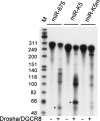The imprinted H19 noncoding RNA is a primary microRNA precursor
- PMID: 17237358
- PMCID: PMC1800509
- DOI: 10.1261/rna.351707
The imprinted H19 noncoding RNA is a primary microRNA precursor
Abstract
Although H19 was the first imprinted noncoding transcript to be identified, the function of this conserved RNA has remained unclear. Here, we identify a 23-nucleotide microRNA derived from H19 that is endogenously expressed in human keratinocytes and neonatal mice and overexpressed in cells transfected with human or mouse H19 expression plasmids. These data demonstrate that H19 can function as a primary microRNA precursor and suggest that H19 expression results in the post-transcriptional downregulation of specific mRNAs during vertebrate development.
Figures



References
-
- Bartel, D.P. MicroRNAs: Genomics, biogenesis, mechanism, and function. Cell. 2004;116:281–297. - PubMed
-
- Bartolomei, M.S., Zemel, S., Tilghman, S.M. Parental imprinting of the mouse H19 gene. Nature. 1991;351:153–155. - PubMed
-
- Brunkow, M.E., Tilghman, S.M. Ectopic expression of the H19 gene in mice causes prenatal lethality. Genes & Dev. 1991;5:1092–1101. - PubMed
-
- Cullen, B.R. Transcription and processing of human microRNA precursors. Mol. Cell. 2004;16:861–865. - PubMed
Publication types
MeSH terms
Substances
Grants and funding
LinkOut - more resources
Full Text Sources
Other Literature Sources
Medical
Molecular Biology Databases
